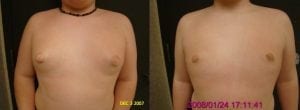Posted January 13, 2011 in Body, Home, Liposuction, Nipple Procedures
Gynecomastia (enlargement of the male breast) is exceedingly common, occurring in up to 30% of teenage boys and 15% of adult males.
Gynecomastia (gyne = female, mastia = breast) is often related to a hormonal imbalance (increased estrogen, decreased testosterone), though most cases are idiopathic (a fancy medical term that loosely translates, “we have no idea what’s causing your problem”). Less common causes of gynecomastia include liver disorders, chronic alcohol use, pituitary tumors, and certain medications (including anabolic steroids).
Breast enlargement in men is often a source of self-consciousness and embarrassment. Many of my patients will not take off their shirts in public. Some wear baggy clothing or multiple T shirts to camouflage their chests.
Diagnosis of gynecomastia is usually made by medical history and exam. If a suspicious mass is found on breast exam, I recommend a mammogram and breast biopsy. If an underlying medical cause is suspected, I recommend evaluation by an endocrinologist.
Treatment of gynecomastia may consist of observation alone (many cases of teenage breast enlargement will resolve spontaneously), treatment of the underlying cause (though an underlying cause is usually not identified), or surgery.
The manifestations of gynecomastia may include:
1. Enlargement of the entire breast (due to excessive fat)
2. Painless or painful lumps or masses beneath the nipple-areolae (due to fibroglandular breast tissue)
3. Puffy or enlarged nipples (due to fibrous tissue immediately beneath the areolae, which are the pigmented areas surrounding the nipples).
I perform male breast reduction surgery on an outpatient basis under general anesthesia in our accredited surgery center on the campus of Texas Health Presbyterian Plano Hospital. In most patients, the surgery consists of liposuction of the breasts to remove excessive fat (through a one-eighth inch incision) followed by direct removal of fibrous tissues beneath the nipples (through an incision along the lower quarter or third of the areola). The incisions are closed using internal, absorbable stitches. There are no external stitches, staples, or drains.
I use a smaller incision than most surgeons and avoid the use of external stitches, since unattractive chest scars will simply give you another reason to be self-conscious about the appearance of your chest. I incorporate liposuction for most men to blend the boundary of tissue removal, minimizing the risk of a “cut-off” between operated and unoperated areas of the breasts.
You will go home about an hour-and-a-half after surgery. You will require pain medication for about 5 to 7 days and should avoid driving and consider taking off from work while on pain medication. A compression garment (very thin version of a life vest) will be required at all times (minus showers) for 4 weeks and intermittently for another 4 weeks. Strenuous exercise should be avoided for 4 weeks.
Male breast reduction for gynecomastia is generally effective in minimizing–not just breast size–but also the self-consciousness and embarrassment that accompany enlargement of the male breast.

We maintain an office in Plano and have performed male breast reduction surgery for patients in Dallas, Frisco, McKinney, Allen, Richardson, Garland, Southlake, Irving, Las Colinas, Grapevine, Colleyville, Carrollton, Lewisville, Denton, and Highland Village. Additional before and after photos of male breast reductions are available on our website.
For more information, please visit www.https://www.plasticsurgerydallas.com or call us at (469) 467-0100.
Ronald M. Friedman, M.D.
Director, West Plano Plastic Surgery Center
Former Chief of Plastic Surgery, Parkland Memorial Hospital, Dallas